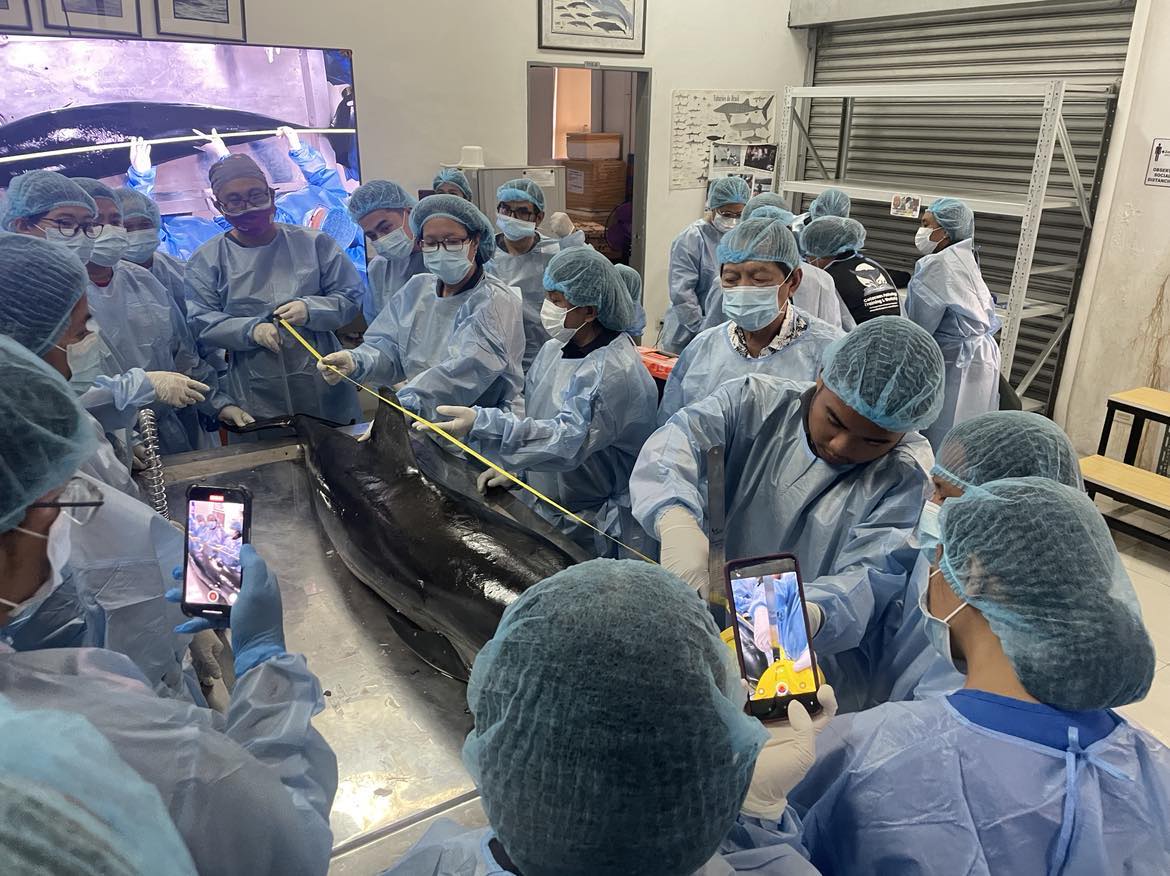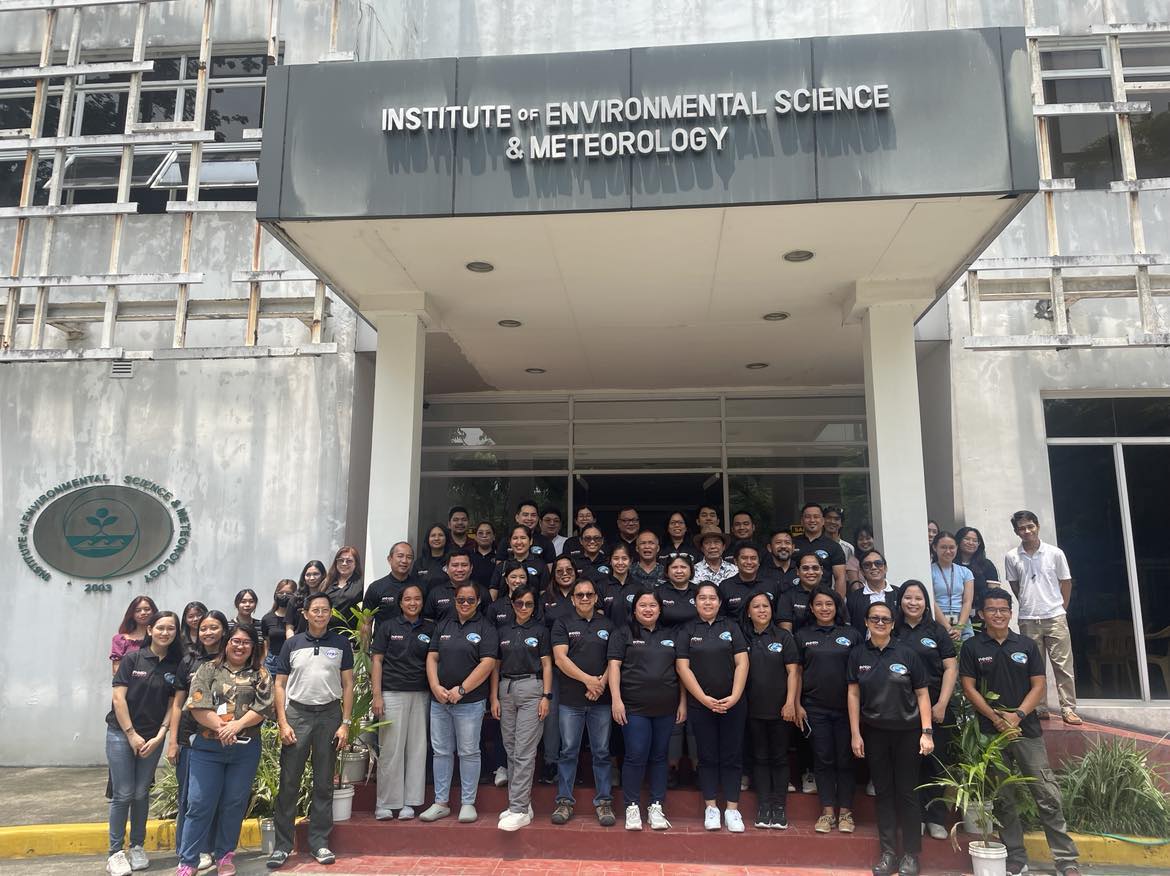‘Death Is Not a Failure’: Enhancing Dolphin Disease Knowledge Through Hands-on Training
Published: July 05, 2024
By: Eunice Jean C. Patron

Veterinarians measuring the length of a spinner dolphin (Stenella coeruleoalba) (Photo credit: Eunice Jean Patron)
Albeit disheartening, scientists said the death of a stranded dolphin is not entirely a setback during the “Cetacean Pathology Training and Workshop: Pathogenesis of Common Diseases in Stranded Dolphins,” held on June 24, 2024, at the University of the Philippines – Diliman College of Science’s Institute of Environmental Science and Meteorology (UPD-CS IESM), Marine Mammal Research and Conservation Laboratory (MMRCL).
The workshop aimed to equip veterinarians with the proper practices and skills for documenting and collecting information about dolphin diseases, ensuring that a dolphin’s death contributes to deepening knowledge about these diseases. It was organized by the MMRCL of IESM, the Microbial Ecology of Terrestrial and Aquatic Systems Laboratory (METAS Lab) of the UPD-CS Institute of Biology (IB), the Philippine Marine Mammal Stranding Network (PMMSN), the Veterinary Practitioners Association of the Philippines (VPAP), and the Philippine Veterinary Medical Association (PVMA).
“We conduct these sorts of training to build the capacity of local government units (LGUs) and concerned agencies in their marine mammal rehabilitation and post-mortem response,” said IESM professor and MMRCL head, Dr. Lemnuel Aragones, who is also the president of PMMSN.
Data presented in the workshop show that human activities, particularly underwater noise pollution such as blasts, significantly impact dolphins. Dr. Leo Jonathan Suarez, PMMSN treasurer and Head of Veterinary Services at Ocean Adventure, mentioned that apart from body tissue injury, blasts can also cause acoustic trauma. “The ear has the most sensitive tissues for pressure-induced damage,” he pointed out. “An adult may not experience or sustain injury from the blast itself. But, of course, the sound travels really far. So, they may actually suffer the consequences of the explosion through that sound.”
As Dr. Suarez showed several examples of suspected acoustic trauma cases, he reiterated that deaf dolphins can survive, yet they will slowly suffer due to hearing loss. “If they cannot echolocate, they cannot find and catch food. They cannot avoid predators. They cannot navigate. They cannot communicate. So basically, all of their skills and abilities to live in the wild are removed,” he added.
Focusing on studies of marine mammal diseases, PMMSN advisory member Dr. Christopher Torno, who mentioned that dolphin deaths are not truly failures, highlighted the importance of dolphin disease knowledge. “Sometimes when people talk about these things, take it with a grain of salt. Tignan niyo rin. As much as possible, I try to superimpose what I’ve learned. And you should too. ‘Yung mga templates natin sa pathology na you might think are useless, they are very useful,” he expounded.
Dr. Torno also reminded the workshop participants to double-check the dolphin’s organs when investigating the cause of its death, even if suspicions already exist. He shared how he has made mistakes during necropsies, illustrating that veterinarians can learn a lot about dolphin diseases through these examinations. ‘The information you’re bringing us will benefit not just you, but this entire network. We’re learning from this, and I’m so happy I can share it with you,’ he said.
Dr. Marie Christine Obusan, an IB professor and one of the heads of the METAS Lab, emphasized the need for more research on dolphin rehabilitation response. “Our country represents one-third of the world’s cetacean diversity,” she explained. “And there is an increasing trend of stranding events over the years.”
As a scientist mainly focused on assessing samples from marine mammal stranding events, Dr. Obusan shared her experiences working with veterinarians in the field. “I’m very appreciative of the inputs I’m getting from different experts and being mentored by different veterinarians,” she said, underscoring how collaborations with people from various fields and expertise, as well as citizens themselves, can be helpful in better understanding marine mammals such as dolphins.

Veterinarians from different LGUs across the Philippines, the Bureau of Fisheries and Aquatic Resources (BFAR), state universities and colleges (SUCs), and private veterinary clinics participated in the workshop. After the morning session lectures by the speakers, the participating veterinarians conducted a dolphin necropsy in the MMRCL room during the afternoon session.
The workshop organizers have also collaborated on other medical management training programs for marine mammals. “The need never ends, as we know that the frequency of strandings continues to increase through the years,” Dr. Aragones mentioned. “We focus on topics we believe are lacking or needed to enhance local capacities.”
This workshop is part of the implementation of a research project on Cetacean health surveillance which is funded by the Department of Science and Technology – Philippine Council for Agriculture, Aquatic and Natural Resources Research and Development (DOST-PCAARRD) through its Marine Resources Research Division.
Dr. Aragones and his team will soon release a scientific paper detailing marine mammal strandings in the Philippines from 2005 to 2022.
For interview requests and other concerns, please contact media@science.upd.edu.ph.
